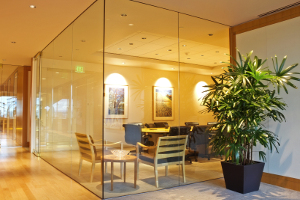Does Your Product Contribute to the LEED v4 Low-Emitting Materials Credit?
- < What Architects Can Teach Building Product Manufacturers
- > Product Manufacturers Take Notice of Perkins + Will’s Precautionary List
There are several significant changes in LEED v4 compared to previous versions of the ratings system. The LEED v4 BD+C Low-Emitting Materials credit has several changes which we will explore. Former individual credit paths have been combined into one credit, with a scaled point system for each path earned. In addition, consideration of furniture emissions has been included for all rating systems. Ceilings are now included and emissions from insulation are now included. The Low-Emitting Materials credit contains many parts, so we will only cover the basics and direct users to more resources.
What Is The LEED v4 Low-Emitting Materials Credit?
The Low-Emitting Materials Credit intent is “to reduce concentrations of chemical contaminants that can damage air quality, human health, productivity, and the environment.” Many types of chemicals, both engineered and naturally occurring, are present everywhere. Volatile organic compounds (VOCs) are chemicals that are released into the air from numerous materials—some of them natural, human-made, plant-based, and from animals, including people. Prolonged exposure to high concentrations of some VOCs has been linked to a wide range of chronic health problems such as asthma, chronic obstructive pulmonary disease, and cancer. Short-term exposure to VOCs can also cause acute reactions, such as eye, nose, and throat irritation.
The LEED v4 Low-Emitting Materials credit includes requirements for product manufacturing as well as project teams. It covers volatile organic compound (VOC) emissions into indoor air and the VOC content of materials, as well as the testing methods by which indoor VOC emissions are determined. Different materials must meet different requirements to be considered compliant for this credit. The building interior and exterior are organized in seven categories, each with different thresholds of compliance. The seven different product categories include:
• Interior paints and coatings applied on site
• Interior adhesives and sealants applied on site (including flooring adhesive)
• Flooring
• Composite Wood
• Ceilings, walls, thermal, and acoustic insulation
• Furniture (include in calculations if part of scope of work)
• Healthcare and Schools Projects only: Exterior applied products
The building interior is defined as everything within the waterproofing membrane. The building exterior is defined as everything outside and inclusive of the primary and secondary weatherproofing system, such as waterproofing membranes and air- and water-resistive barrier materials. The move to include emissions testing, which is new to LEED v4, it represents a better way of assessing products, as only emitted VOCs are issues for air quality. There is Additional VOC content requirements for wet-applied products. In addition to meeting the general requirements for VOC emissions, on-site wet-applied products must not contain excessive levels of VOCs, for the health of the installers and other workers who are exposed to these products.

This credit uses the California Department of Public Health (CDPH) Standard Method for the Testing and Evaluation of Volatile Organic Chemical Emissions from Indoor Sources Using Environmental Chambers, v.1.1-2010 for the emissions testing and requirements of all products and materials except furniture. The method, widely recognized as a leadership standard for its stringent scientific criteria and detailed specificity, was developed through an open, consensus process. It uses the chronic reference exposure levels established by the California Office of Environmental Health Hazard Assessment, which include some of the most stringent criteria in use. For building product manufacturers who are new to product emissions testing, the first step is often the CDPH Standard Method.
To demonstrate compliance, a building product or layer must meet all of the following requirements, as applicable.
Inherently Non-Emitting Sources
Products that are inherently non-emitting sources of VOCs (stone, ceramic, powder-coated metals, plated or anodized metal, glass, concrete, clay brick, and unfinished or untreated solid wood flooring) are considered fully compliant without any VOC emissions testing if they do not include integral organic- based surface coatings, binders, or sealants.
General Emissions Evaluation
Building products must be tested and determined compliant in accordance with California Department of Public Health (CDPH) Standard Method v1.1–2010, using the applicable exposure scenario. The default scenario is the private office scenario. The manufacturer’s or third-party certification must state the exposure scenario used to determine compliance. Claims of compliance for wet-applied products must state the amount applied in mass per surface area.
Additional VOC Content Requirements For Wet-Applied Products.
In addition to meeting the general requirements for VOC emissions, on-site wet-applied products must not contain excessive levels of VOCs, for the health of the installers and other trades workers who are exposed to these products. To demonstrate compliance, a product or layer must meet the following requirements, as applicable. Disclosure of VOC content must be made by the manufacturer. Any testing must follow the test method specified in the applicable regulation.
All paints and coatings wet-applied on site must meet the applicable VOC limits of the California Air Resources Board (CARB) 2007, Suggested Control Measure (SCM) for Architectural Coatings, or the South Coast Air Quality Management District (SCAQMD) Rule 1113, effective June 3, 2011.
Does your product contribute to the Low-Emitting Materials credit? What certifications/testing does your company use to meet the LEED requirements?
For more information or to discuss the topic of this blog, please contact Brad Blank





